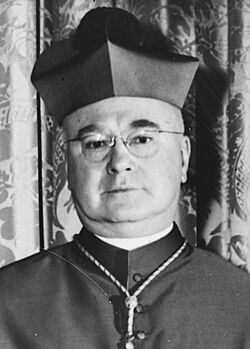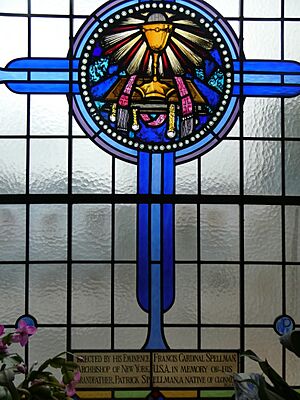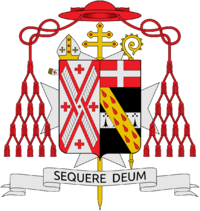Francis Spellman facts for kids
Quick facts for kids His Eminence Francis Spellman |
|
|---|---|
| Cardinal, Archbishop of New York |
|

Spellman in 1946
|
|
| Church |
|
| Archdiocese | New York |
| Appointed | April 15, 1939 |
| Enthroned | May 23, 1939 |
| Reign ended | December 2, 1967 |
| Predecessor | Patrick Joseph Hayes |
| Successor | Terence Cooke |
| Other posts |
|
| Orders | |
| Ordination | May 14, 1916 |
| Consecration | September 8, 1932 by Eugenio Pacelli |
| Created Cardinal | February 18, 1946 |
| Rank | Cardinal Priest |
| Personal details | |
| Birth name | Francis Joseph Spellman |
| Born | May 4, 1889 Whitman, Massachusetts, U.S. |
| Died | December 2, 1967 (aged 78) Manhattan, New York City, U.S. |
| Buried | St. Patrick's Cathedral, New York |
| Previous post |
|
| Education |
|
| Motto | Sequere Deum (Follow God) |
Francis Joseph Spellman (born May 4, 1889 – died December 2, 1967) was an important leader in the Catholic Church in America. He served as the sixth archbishop of the Archdiocese of New York from 1939 until his death.
Before this, Spellman was an auxiliary bishop in the Archdiocese of Boston from 1932 to 1939. He became a cardinal in 1946, which is a very high rank in the Catholic Church.
Contents
Growing Up and School

Francis Spellman was born in Whitman, Massachusetts. His parents were William and Ellen Spellman. His grandparents had moved to the United States from Ireland. Francis had two younger brothers, Martin and John, and two younger sisters, Marian and Helene.
Spellman went to Whitman High School because there wasn't a Catholic school in his town. He liked photography and played first base on the baseball team until he hurt his hand. After that, he managed the team.
In 1907, Spellman started college at Fordham University in New York City. He graduated in 1911 and decided he wanted to become a priest. He was then sent to study at the Pontifical North American College in Rome, Italy. He got very sick with pneumonia there, but he stayed and finished his studies. While in Rome, he became friends with people who would later become cardinals.
Becoming a Priest
Spellman became a priest in Rome on May 14, 1916. When he returned to the United States, he was given jobs in different church parishes. At first, his assignments were not very important.
During World War I, which started for the U.S. in 1917, Spellman tried to join the army as a military chaplain. However, he was too short. He also tried to join the US Navy as a chaplain, but his application was turned down twice.
Later, he was assigned to help with the archdiocese's newspaper, The Pilot. In 1918, he became an assistant chancellor, and in 1924, he became the archivist for the archdiocese.
In 1925, Spellman was appointed as the first American to work for the Vatican Secretariat of State. This was after he translated two books into English. While working there, he also helped the Knights of Columbus run playgrounds for children in Rome. In 1926, Pope Pius XI gave him the title of privy chamberlain.
In 1927, Spellman became good friends with Archbishop Eugenio Pacelli during a trip to Germany. Pacelli later became Pope Pius XII. Spellman also helped translate Pope Pius XI's first radio broadcast in 1931. He also helped improve the Vatican's press office.
Becoming a Bishop
Auxiliary Bishop of Boston
On July 30, 1932, Pope Pius XI chose Spellman to be an auxiliary bishop of Boston. He was also named titular bishop of Sila. Spellman was consecrated as a bishop on September 8, 1932, in St. Peter's Basilica in Rome. He was the first American to become a bishop in St. Peter's. His motto was Sequere Deum, which means "Follow God."
After returning to the United States, Spellman lived at St. John's Seminary in Boston. He later became the pastor of Sacred Heart Parish, where he helped pay off the church's debt.
In 1936, Archbishop Pacelli visited the United States. Spellman helped arrange a meeting between Pacelli and President Roosevelt. The main reason for this visit was to discuss the United States recognizing Vatican City as a country.
Spellman also became friends with Joseph P. Kennedy Sr., a wealthy Catholic and the US ambassador to the United Kingdom. Over the years, Spellman performed the marriage ceremonies for several of Kennedy's children, including future senators Robert F. Kennedy and Edward Kennedy.
Archbishop of New York
After Pope Pius XI died, Pacelli was chosen as the new Pope, taking the name Pius XII. One of his first actions was to appoint Spellman as the sixth archbishop of New York on April 15, 1939. Spellman officially took on this role on May 23, 1939. He started the first regular Spanish-language masses in the archdiocese.
Besides being the leader of the New York archdiocese, Pius XII also made Spellman the apostolic vicar for the U.S. Armed Forces in December 1939. This meant he was in charge of Catholic services for military members. Spellman often spent Christmases with American troops overseas.
During his time in New York, Spellman had a lot of influence in both religious and political matters. His home was even called "the Powerhouse" because so many important people visited him. In 1945, Spellman started the Al Smith Dinner, an annual event that raises money for Catholic Charities.
Spellman also became a close advisor to President Roosevelt during World War II. In 1943, Roosevelt asked Spellman to visit 16 countries in Europe, Africa, and the Middle East. As an archbishop and military vicar, he could travel more freely than official diplomats. During the war in Italy, Spellman helped communicate between Pope Pius XII and Roosevelt to try and declare Rome an open city. This would have saved it from bombing and fighting.
Becoming a Cardinal
| Styles of Francis Spellman |
|
|---|---|
 |
|
| Reference style | His Eminence |
| Spoken style | Your Eminence |
| Informal style | Cardinal |
| See | New York |
Pope Pius XII made Spellman a Cardinal-Priest on February 18, 1946. This was a very important step in his career.
In 1949, when gravediggers at Calvary Cemetery in Queens went on strike for better pay, Cardinal Spellman strongly opposed their actions. He even brought in students from the seminary to do the work.
Spellman played a role in getting William J. Brennan Jr. appointed to the Supreme Court in 1956. He later took part in the 1958 papal conclave that elected Pope John XXIII.
Spellman had a long friendship with Joseph P. Kennedy Sr.. He also worked to help the growing Puerto Rican community in New York City. He sent priests to learn Spanish, and by 1960, many parishes had programs for Spanish-speaking Catholics. As a cardinal, Spellman oversaw the building of many new churches, schools, and other institutions. He also founded three schools in Ecuador.
Second Vatican Council
Spellman attended the Second Vatican Council from 1962 to 1965. This was a major meeting of Catholic leaders to discuss changes in the Church. He was part of the council's leadership. Spellman was a traditional thinker and did not support all the changes. For example, he preferred that Mass continue to be in Latin rather than local languages.
In 1963, Spellman brought Reverend John Courtney Murray to the Council as an expert. Murray's work was very important in shaping the council's statement on religious freedom.
After Pope John XXIII died, Spellman participated in the conclave of 1963 that elected Pope Paul VI. Spellman also agreed to President Johnson's request to send priests to the Dominican Republic in 1965 to help calm anti-American feelings after a U.S. intervention.
Spellman was known for his financial skills. He helped the archdiocese build many churches, schools, and hospitals. He was sometimes called "Cardinal Moneybags" because of his ability to manage money.
Later Life and Death
In 1966, Pope Paul VI asked bishops to retire at age 75. Spellman offered to resign, but the Pope asked him to stay in his role.
Spellman died in New York City on December 2, 1967, at 78 years old. He was buried in the crypt under the main altar at St. Patrick's Cathedral. Many important people attended his funeral, including President Johnson and Vice President Hubert Humphrey.
His Views
Civil Rights
Spellman personally did not like public demonstrations during the Civil Rights Movement. However, he did not condemn Martin Luther King Jr. when asked by J. Edgar Hoover. He also helped fund a trip for New York priests and nuns to the 1965 Selma to Montgomery marches. Spellman was against racial discrimination in housing.
Communism
Spellman strongly believed that Americans should oppose Communism. He said that "a true American can neither be a Communist nor a Communist condoner." He also supported Senator Joseph McCarthy's investigations into Communism in the government.
As early as 1954, Spellman warned the government about the spread of communism in French Indochina. He met Ngô Đình Diệm, who would become the president of South Vietnam, and was impressed by his strong anti-Communist views. After the French lost a major battle in 1954, Spellman urged the U.S. government to get involved in the conflict.
When the United States entered the Vietnam War in 1965, Spellman became a very strong supporter of the war. He visited troops in South Vietnam during Christmas 1965. He called the Vietnam War a "war for civilization" and "Christ's war against the Vietcong and the people of North Vietnam."
Some critics called the Vietnam War "Spelly's War" because of his strong support. Antiwar protestors sometimes demonstrated against him. His support for the war, along with his traditional views on church reform, reduced his influence.
Politics
Spellman spoke out against efforts to provide federal money only to public schools, calling it "religious prejudice against Catholic children."
He also had a public disagreement in 1949 with former First Lady Eleanor Roosevelt. She wrote in her newspaper column that she was against federal funding for religious schools. Spellman accused her of being anti-Catholic. They later met and settled their disagreement.
When John F. Kennedy ran for president in 1960, Spellman supported his opponent, Richard Nixon, who was not Catholic. This was because Kennedy did not support federal aid for religious schools or having a U.S. Ambassador to the Vatican. Spellman's support for Nixon ended his long friendship with the Kennedy family.
In the 1964 election, Spellman supported President Lyndon B. Johnson. Johnson's laws had helped the Catholic Church a lot.
Films and Plays
Spellman often spoke out against films and plays he believed were harmful to public morals.
- He called the 1941 film Two-Faced Woman "dangerous to public morals."
- He condemned the 1947 film Forever Amber.
- He described the 1948 film The Miracle as "a despicable affront to every Christian."
- He called the 1956 film Baby Doll "revolting" and "morally repellent."
- When The Deputy, a play about Pope Pius XII during the Holocaust, opened in 1964, Spellman said it was "an outrageous desecration."
Awards and Recognition
- Gold Medal Award from The Hundred Year Association of New York – 1946
- Distinguished Service Medal from the American Legion – 1963
- Sylvanus Thayer Award by the United States Military Academy at West Point – 1967
Legacy
Historian Russell Shaw said that Spellman represented how American and Catholic identities came together in the mid-20th century. His support for John Courtney Murray helped shape the Second Vatican Council's Declaration on Religious Freedom. Spellman is remembered for his kindness to individuals and for the many religious and charitable organizations he helped create or strengthen.
The novel The Cardinal (1950) by Henry Morton Robinson was partly based on Spellman's life. It was later made into a film of the same name in 1963.
In 1947, a building at Fordham University, Spellman's old college, was named in his honor.
See also
- Cardinal Spellman High School (Brockton, Massachusetts)
- Cardinal Spellman High School (The Bronx, New York City)
- Catholic Church in the United States
- Hierarchy of the Catholic Church
- Historical list of the Catholic bishops of the United States
- List of Catholic bishops of the United States: military service
- Lists of popes, patriarchs, primates, archbishops, and bishops
- Spellman Museum of Stamps and Postal History


